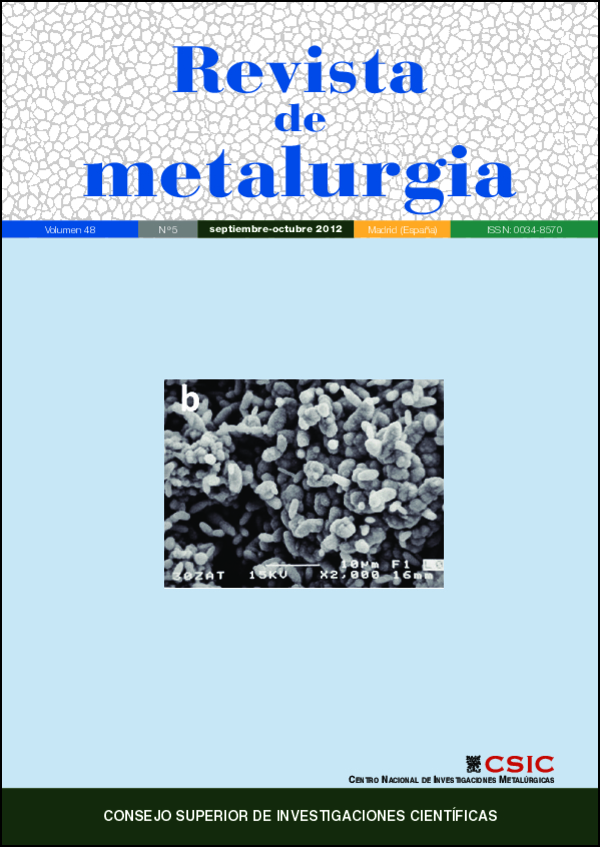Optimization of GMAW process of AA 6063-T5 aluminum alloy butt joints based on the response surface methodology and on the bead geometry
DOI:
https://doi.org/10.3989/revmetalm.1169Keywords:
Welding, Optimization, Aluminum, Response Surface Methodology (RSM), GMAWAbstract
The geometry of the weld beads is characterized by the overhead, the width and the penetration. These values are indices of the behavior of the welded joint and therefore, they can be considered as factors that control the process. This work is performed to optimize the GMAW process of the aluminum alloy AA 6063-T5 by means of the response surface methodology (RSM). The variables herein considered are the arc voltage, the welding speed, the wire feed speed and the separation between surfaces in butt joints. The response functions that are herein studied are the overhead, the width, the penetration and the angle of the bead. The obtained results by RSM show high grade of agreement with the experimental values. The procedure is experimentally validated by welding for the theoretically obtained optimized technological conditions and a wide agreement between theoretical and experimental values is found.
Downloads
References
[1] B.K. Srivastava, S.P. Tewar y J. Prakash, Int. J. Engineer. Sci. Technol. 2 (2010) 1.425-1.432.
[2] AWS, Welding Handbook, Vol. 2. Welding Processes, 8th ed., 2001, pp. 47-65.
[3] A.M. Al-Mukhtar, H. Biermann, P. Hübner y S. Henkel, J. Mater. Eng. Perform. 19 (2010) 1.225-1.234. http://dx.doi.org/10.1007/s11665-009-9411-0
[4] G. Kumar y K.N. Prabhu, Adv. Colloid. Interfac. 133 (2007) 61-89. http://dx.doi.org/10.1016/j.cis.2007.04.009 PMid:17560842
[5] J.C. Mc Glone y D.B. Chadwick, Welding Institute Report 80 (1978) 256-263.
[6] E. Karadeniz, U. Ozsarac y C. Yildiz, Mater. Design. 28 (2007) 649-656. http://dx.doi.org/10.1016/j.matdes.2005.07.014
[7] M.A. Wahab y M.J. Painter, J. Pm. Ves. & Piping 73 (1997) 153-159. http://dx.doi.org/10.1016/S0308-0161(97)00049-5
[8] I.S. Kim, C.E. Park, Y.J. Jeong y J.S. Son, Int. J. Adv. Manuf. Techn. 18 (2001) 98-102. http://dx.doi.org/10.1007/s001700170080
[9] I.S. Kim, J.S. Son, I.G. Kim, J.Y. Kim y O.S. Kim, J. Mater. Process. Tech. 136 (2003) 139-145. http://dx.doi.org/10.1016/S0924-0136(02)01126-3
[10] P.E. Murray y A. Scotti, Sci. Technol. Weld. Joi. 4 (1999) 112-117. http://dx.doi.org/10.1179/136217199101537644
[11] M. Dorta, J. Vidal, A. Mateo, G. Fargas y F. Camejo, Dyna 78 (2011) 206-215.
[12] M.C. Payares, C. De Barros, P. Muñoz y Z. Cassier, Rev. Latinoamericana de Metalurgia y Materiales 17 (1997) 5-12.
[13] V. Aleo, M.K.S. Madugula y R. Balachandar, Canadian Journal of Civil Engineering Publisher 33 (2006) 151-160. http://dx.doi.org/10.1139/l05-099
[14] V. Miguel, A. Martínez, M.C Manjabacas, J. Coello y A. Calatayud, AIP Conference Proceedings,1, New York, USA, AMER INST. PHYSICS, 2009, pp. 170-179.
[15] D. Hoffman, K. Dable y D. Fisher, Welcome to welding, Ed. Pearson Education Limited), USA, 2010, pp. 69-75.
[16] M. Estrems, E.J. Martínez-Conesa y V. Miguel, Dyna 84 (2009) 251-258.
Downloads
Published
How to Cite
Issue
Section
License
Copyright (c) 2012 Consejo Superior de Investigaciones Científicas (CSIC)

This work is licensed under a Creative Commons Attribution 4.0 International License.
© CSIC. Manuscripts published in both the printed and online versions of this Journal are the property of Consejo Superior de Investigaciones Científicas, and quoting this source is a requirement for any partial or full reproduction.All contents of this electronic edition, except where otherwise noted, are distributed under a “Creative Commons Attribution 4.0 International” (CC BY 4.0) License. You may read here the basic information and the legal text of the license. The indication of the CC BY 4.0 License must be expressly stated in this way when necessary.
Self-archiving in repositories, personal webpages or similar, of any version other than the published by the Editor, is not allowed.
















